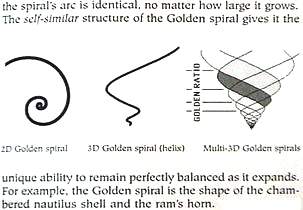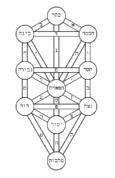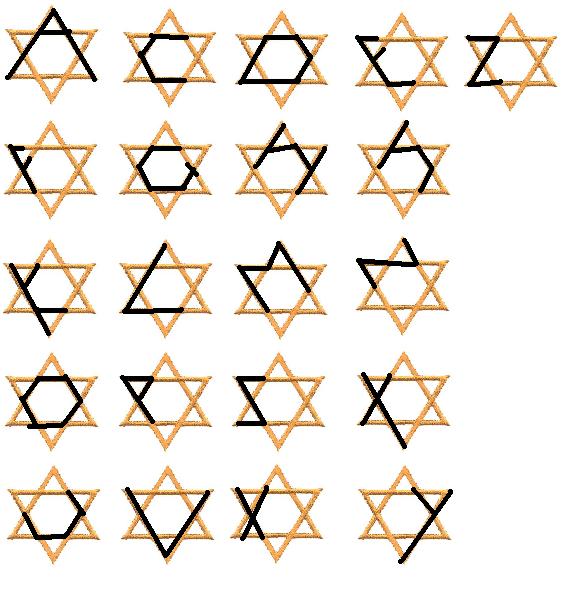It looks like you're using an Ad Blocker.
Please white-list or disable AboveTopSecret.com in your ad-blocking tool.
Thank you.
Some features of ATS will be disabled while you continue to use an ad-blocker.
share:
reply to post by Americanist

All on the same page
“Today, a young man on acid realized that all matter is merely energy condensed to a slow vibration — that we are all one consciousness experiencing itself subjectively.” ... “Here's Tom with the weather.”

All on the same page
reply to post by Americanist
This thread is bogus, Hebrew alphabet predates the star of david by 1000 years. How can you design an alphabet on a future symbol?
This thread is bogus, Hebrew alphabet predates the star of david by 1000 years. How can you design an alphabet on a future symbol?
reply to post by Quark
It's a shame the Star of David, was never the Star of David, and predates the use as such...
It's a shame the Star of David, was never the Star of David, and predates the use as such...
reply to post by dogstar23
I would LOVE to become a Rosicrucian. However, I do not believe we have any temples in my state.
I would LOVE to become a Rosicrucian. However, I do not believe we have any temples in my state.
Pretty sure I could represent every single letter of the English alphabet... with that many lines crossing, it is a mathematical certainty tha ANY
desired 'letter' just about could be created!
(even some of the ones, here, are a stretch)
Not impressed. S&F for thinking outside the box, though.
(even some of the ones, here, are a stretch)
Not impressed. S&F for thinking outside the box, though.
reply to post by adjensen
And you tell him to drop the elitist attitude.....Shut up hypocrite, Jesus would be ashamed of you...
And you tell him to drop the elitist attitude.....Shut up hypocrite, Jesus would be ashamed of you...
reply to post by theabsolutetruth
Solomon was not a person. The story is an allegory, which I thought I explained with the SOL-OM-ON, being three names of the Sun. How can the use be considered dated after the language, when the Seal, was never used as such. I'm my assertion is that the Seal of SOL-OM-ON, is where there letters were derived from, because the Seal is the creation of everything. This gets deeper into Occult knowledge, like Hermetic Order of the Golden Dawn, and etc.
/E: I noticed my tone in the beginning sounded a bit ill; I'm not, I'm merely commenting and inquiring. I don't understand how you could still come to the conclusion that you did. Although I always welcome and respect alternate opinions.
The Star is not so much a symbol but what it also represents. The meaning behind the star is older than the Hebrew language. I think that's a good statement to end on to clear the confusion on my part, and actually understand where I am going with this.
Solomon was not a person. The story is an allegory, which I thought I explained with the SOL-OM-ON, being three names of the Sun. How can the use be considered dated after the language, when the Seal, was never used as such. I'm my assertion is that the Seal of SOL-OM-ON, is where there letters were derived from, because the Seal is the creation of everything. This gets deeper into Occult knowledge, like Hermetic Order of the Golden Dawn, and etc.
/E: I noticed my tone in the beginning sounded a bit ill; I'm not, I'm merely commenting and inquiring. I don't understand how you could still come to the conclusion that you did. Although I always welcome and respect alternate opinions.
The Star is not so much a symbol but what it also represents. The meaning behind the star is older than the Hebrew language. I think that's a good statement to end on to clear the confusion on my part, and actually understand where I am going with this.
edit on 11-8-2012 by VeritasAequitas
because: (no reason given)
reply to post by Quark
Gotta love how people who lurk and have made 5 posts in nearly 7 years, yet have the audacity to dump on someone's thread. Try creating your own next time, pal!
Gotta love how people who lurk and have made 5 posts in nearly 7 years, yet have the audacity to dump on someone's thread. Try creating your own next time, pal!
I just would like to share something related to the hebrew alphabet and geometry. And it relates to Radionics (and thus, to Shape Waves, and
Radiesthesia, also).
Did you consider that there are ONLY 22 polygons that can be inscribed in a circle which have an integer number of degrees? Just the same number of letters of the alphabet. Is that by chance?...
But it goes even further. When you write any ancient word in hebrew, the vibration (under a radiesthesic point of view) of the written word is the same as the object/concept it means (a connection between semantics and language in an amazing and incredible manner).
I think there are many unknown aspects of this language to be discovered (or better, uncovered) yet...
Did you consider that there are ONLY 22 polygons that can be inscribed in a circle which have an integer number of degrees? Just the same number of letters of the alphabet. Is that by chance?...
But it goes even further. When you write any ancient word in hebrew, the vibration (under a radiesthesic point of view) of the written word is the same as the object/concept it means (a connection between semantics and language in an amazing and incredible manner).
I think there are many unknown aspects of this language to be discovered (or better, uncovered) yet...
The hexagram is a mandala symbol called satkona yantra or sadkona yantra found on ancient South Indian Hindu temples. It symbolizes the nara-narayana, or perfect meditative state of balance achieved between Man and God, and if maintained, results in "moksha," or "nirvana" (release from the bounds of the earthly world and its material trappings).[citation needed] Another theory, though apparently not very substantiated, about the origin of the shape is that it is simply 2 of the 3 letters in the name David: in its Hebrew spelling, David is transliterated as "D-V-D." In Biblical Hebrew, the letter "D" (Dalet) was written in a form like an upside-down and backwards "L," but when seen in the Greek, the letter "Delta" (Δ) is a triangle. The symbol may have been a simple family crest formed by flipping and juxtaposing the two most prominent letters in the name. The letter "W" in this case could reference the compositing operation of the two Deltas.
Anahata (also known as Anahata-puri, or padma-sundara) is related to the thymus, located in the chest. The thymus is an element of the immune system as well as being part of the endocrine system. It is the site of maturation of the T cells responsible for fending off disease and may be adversely affected by stress. Anahata is symbolized by a lotus flower with twelve petals. (See also heartmind). Anahata is related to the colors green or pink. Key issues involving Anahata involve complex emotions, compassion, tenderness, unconditional love, equilibrium, rejection and well-being. Physically Anahata governs circulation, emotionally it governs unconditional love for the self and others, mentally it governs passion, and spiritually it governs devotion.[2]
This is a concept of Hinduism, that is denoted by the Hexagram.
en.wikipedia.org...
Hebrew -> en.wikipedia.org...
The earliest examples of written Hebrew date from the 10th century BCE.
Which if you consult your friendly Wikipedia, Hinduism predates Hebrew.
This all being said, I would like somebody to explain to me how Hebrew predates the Star of David, when the Star of David isn't even Hebrew or Jewish, or Christian for that matter. I digress.
edit on 11-8-2012 by VeritasAequitas because: (no reason given)
Originally posted by TheMatrixusesYou
Originally posted by renegadeloser
Alphabet Alpha-bet Aleph Bet
Exactly. Utterly bet-less.
I can appreciate what you were trying to do there-- but your version is far more selective than OP's and seems to leave out some letters of the english "aleph bet," namely the 4 letters I assume you had difficulty fitting.
OP-- this is a really interesting observation. The hebrew alphebet is fascinating and has many correspondences, for those who bother to study it. Those who would scoff the notion that the letters might have the basis of their physical formation in the geometry of a holy symbol, have clearly never studied hebrew much.
Did you know that each hebrew letter is a number? Did you know that each letter, also, can be a stand-alone concept? Each represents a thing. I have read that the shapes of the letters in many or all cases may even be based on (shape related to) that which they are supposed to represent. As such, this idea doesn't seem all that far-fetched. Look into "Gematria" for a deeper rabbit hole.
Interesting catch, OP. Thank you.
edit on 11-8-2012 by iwilliam because: removed double-quote
Originally posted by adjensen
No, that is not correct. The Gospel of Thomas, as presented, is as complete as we know it to be -- there is nothing left out.
And this, to the best of my knowledge, is incorrect. Thomas, as with much of the naghammadi library had bits and pieces missing. More on the order of single letters, words, or phrases, than actual passages (in most places).
If you view a good translation, you will see the scholars indicate where they are "filling in" the missing bits.
reply to post by ReallyNiceGuy
What in the world do aliens have to do with Christianity in the context that you just said? Please explain that to me.. How does saying "No wonder the aliens have quarantined us" = "Aliens control and have contained us here by stopping us from leaving with their Kamehameha beams."
You can't, because that I didn't say that. By quarantine, I mean not having anything to do with us on a public level. Letting us think we are the only cats in the jungle. Ever played that game where you stick your nose in the corner and you aren't allowed to play with the other good little boys and girls? That is called timeout.
What in the world do aliens have to do with Christianity in the context that you just said? Please explain that to me.. How does saying "No wonder the aliens have quarantined us" = "Aliens control and have contained us here by stopping us from leaving with their Kamehameha beams."
You can't, because that I didn't say that. By quarantine, I mean not having anything to do with us on a public level. Letting us think we are the only cats in the jungle. Ever played that game where you stick your nose in the corner and you aren't allowed to play with the other good little boys and girls? That is called timeout.
edit on 11-8-2012 by VeritasAequitas because: (no reason given)
reply to post by iwilliam
I am attempting to use this method to teach myself Hebrew; I'll need it to read some of the Occult texts on the Kabbalah.
I am attempting to use this method to teach myself Hebrew; I'll need it to read some of the Occult texts on the Kabbalah.
reply to post by Photagoras
Thread
Thread
Thread
Mastermind intellect is defined by both the Hebrew and English languages. Not only do these acquiesce to vowel sounds, but the former ramps up shapes.
Thread
I'm sure we can both agree language shapes perception... Some see the sky as drab simply because a particular color isn't associated with logic.
Thread
Words contain vowel sounds... The connection to melody and rhythm. If so inclined, you're also able to decipher with a catalog of definitions. At some point we hone in on common sense...
Thread
Originally posted by VeritasAequitas
reply to post by Americanist
That's from Bill Hicks/Tool...It's in my sig
Be sure to scroll down the page... It's worth your time and effort. Wish I had known about Walter Russell as I started my journey. It wasn't until last year I found his research. Anyhow, what I viewed as a step pyramid, he managed to illustrate as more a tall building. Everything else seemed to fall into place as well.
reply to post by Americanist
Did you know that based on one of your above post, when you take the tetragrammaton of Yehovah, and stack the letters on top of each other, it also forms what looks like the Kabbalah with the capstone missing?
H
V
H
Y
Did you know that based on one of your above post, when you take the tetragrammaton of Yehovah, and stack the letters on top of each other, it also forms what looks like the Kabbalah with the capstone missing?
H
V
H
Y
Originally posted by VeritasAequitas
reply to post by Americanist
Did you know that based on one of your above post, when you take the tetragrammaton of Yehovah, and stack the letters on top of each other, it also forms what looks like the Kabbalah with the capstone missing?
H
V
H
Y
I hadn't made the direct connection... I've stuck with the sounds. Good eye btw:

reply to post by VeritasAequitas

Was the quote that I was referring to, but upon further inspection, found out that it was from someone else.
However this was all I read, when briefly seeing the quote a split second.
And my own brain filled in the Kabbalah.

In the illustration below you will see how the Divine Tetragrammaton (the Name of Yahweh) is viewed by them in anthropomorphic terms, the letters stacked one on top of the other to make the outline of their god-man, Adam Kadmon
Was the quote that I was referring to, but upon further inspection, found out that it was from someone else.
However this was all I read, when briefly seeing the quote a split second.
Divine Tetragrammaton (name of Yahweh), the letters stacked one on top of the other to make the outline of...
And my own brain filled in the Kabbalah.
edit on 11-8-2012 by VeritasAequitas because: (no reason given)
new topics
-
This should be plastered all over the airwaves
Mainstream News: 1 hours ago -
Oh, Good Gosh. “Kremlin Warns Stay Away from Greenland.”
World War Three: 3 hours ago -
Archbisop Vigano Warns of Deep State and Deep Church
New World Order: 3 hours ago -
A Flash of Beauty: Bigfoot Revealed ( documentary )
Cryptozoology: 9 hours ago
top topics
-
Fire insurance in LA withdrawn months ago
General Conspiracies: 12 hours ago, 8 flags -
This should be plastered all over the airwaves
Mainstream News: 1 hours ago, 8 flags -
A Flash of Beauty: Bigfoot Revealed ( documentary )
Cryptozoology: 9 hours ago, 7 flags -
Oh, Good Gosh. “Kremlin Warns Stay Away from Greenland.”
World War Three: 3 hours ago, 6 flags -
Archbisop Vigano Warns of Deep State and Deep Church
New World Order: 3 hours ago, 5 flags
active topics
-
Trump says ownership of Greenland 'is an absolute necessity'
Other Current Events • 120 • : Flyingclaydisk -
Judge rules president-elect Donald Trump must be sentenced in 'hush money' trial
US Political Madness • 89 • : xuenchen -
This should be plastered all over the airwaves
Mainstream News • 10 • : BeyondKnowledge3 -
Los Angeles brush fires latest: 2 blazes threaten structures, prompt evacuations
Mainstream News • 303 • : xuenchen -
Post A Funny (T&C Friendly) Pic Part IV: The LOL awakens!
General Chit Chat • 8012 • : underpass61 -
The Acronym Game .. Pt.4
General Chit Chat • 1040 • : bally001 -
To become president, Zelensky had to learn Ukrainian
Political Conspiracies • 35 • : Oldcarpy2 -
Oh, Good Gosh. “Kremlin Warns Stay Away from Greenland.”
World War Three • 10 • : Imhere -
Fire insurance in LA withdrawn months ago
General Conspiracies • 26 • : sapien1982 -
The Truth about Migrant Crime in Britain.
Social Issues and Civil Unrest • 45 • : covent

